Alpha Flight (1st series) – (1983-1994)
Although their last appearance in X-Men was published in late 1980, it would not be until fall 1983 that Alpha Flight #1 would debut. When it did, Byrne started off almost exactly where the team left off, with Department H defunded, its headquarters stripped of its equipment and all of the Alphans 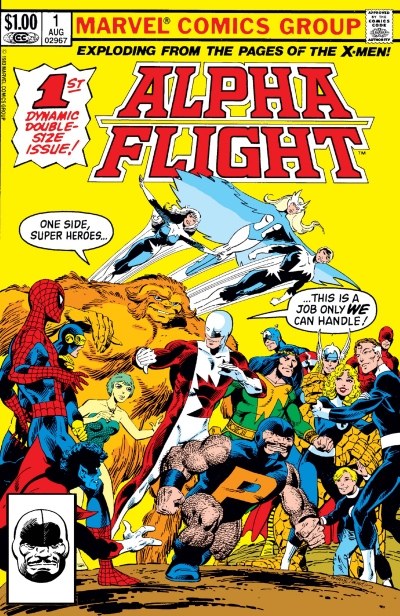 moving on to civilians lives and careers. As such, Byrne’s first task was to “get the band back together” and to do so introduced Tundra, the first of the “Great Beasts” that would be perennial mystic foes of the team. Along the way, he also introduced two new characters – Puck and Marrina, members of Alpha Flight’s training squad, Beta Flight. (Basically in hindsight, Byrne revealed "Alpha" Flight was a multi-tiered program, with Beta Flight and Gamma Flight trainees being given the boot as well, before we even met them.) By the end of the story, the former Alphans agreed to re-form Alpha Flight, even without government funding or sanction. With #2, Byrne rectified an issue that had been bothering him since “Weapon Alpha’s” first appearance and gave him the codename he always wanted: Guardian.
moving on to civilians lives and careers. As such, Byrne’s first task was to “get the band back together” and to do so introduced Tundra, the first of the “Great Beasts” that would be perennial mystic foes of the team. Along the way, he also introduced two new characters – Puck and Marrina, members of Alpha Flight’s training squad, Beta Flight. (Basically in hindsight, Byrne revealed "Alpha" Flight was a multi-tiered program, with Beta Flight and Gamma Flight trainees being given the boot as well, before we even met them.) By the end of the story, the former Alphans agreed to re-form Alpha Flight, even without government funding or sanction. With #2, Byrne rectified an issue that had been bothering him since “Weapon Alpha’s” first appearance and gave him the codename he always wanted: Guardian.
With the team formed anew, Byrne spent most of the next year fleshing out the characters through solo backup stories. Along with stories that were in the “present,” issues #2-3 and #5-11 contained 5-9 page stories that told the origins of Guardian, Shaman, Snowbird, Aurora, Northstar and finally Sasquatch. As these characters were blank slates and had no sacrosanct traits established by the likes of Stan Lee or Jack Kirby, Byrne enjoyed freedom for his characters to experiment. Aurora was given mental issues that today are known as dissociative identity disorder. Shaman was given a fully rounded character arc for his origin, showing a Native American who favored the science of the 20th century and rejected his heritage, only later to embrace it – and becoming estranged from his daughter along the way. For verisimilitude, Byrne also delved slightly into Canadian politics, specifically the English-French divide between Quebec and the rest of Canada. To that end, Northstar was given a backstory as being part of the militant group Front de libération du Québec, who were violent proponents of the Quebec “séparatiste” movement. Likewise, both he and his sister Aurora were continuously shown that French was their first (and preferred) language.
For Northstar, Byrne also attempted to do what was very difficult in the confines of the era – write a character who was gay. Of course, for the time, it might have been impossible for Byrne to make this an explicit fact, so he utilized what would later be known as “queer coding.” As such, a reader could not be faulted for reading all of Northstar’s stories and never picking up on the subtext. For others, however, or for whom the subtext had been later pointed out, Byrne dropped hints. The earliest example of this was when Northstar ran into an old friend, Raymonde Belmonde, who years before had “led him out” of a dark fear and “into the bright clear light of self-acceptance.” There would be other such hints later by Byrne and in the runs of writers that followed. However, it was not until Alpha Flight #106 in 1992 that Marvel editorial would feel comfortable enough for the character to speak openly about his homosexuality.
By #12, Byrne had firmly established his characters, their backstory and their status quo as Canada’s premiere super-heroes. However, with the series 12th issue, Byrne arguably began his second act of his run, upending the very status quote he had just established. To the shock of 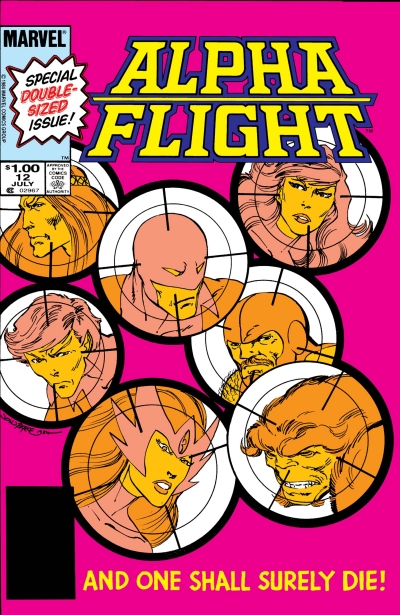 readers, this upheaval began with the death of the team’s founder and leader, Guardian. Speaking out about it later, Byrne made clear that he had found Guardian to be the least interesting of the series’ characters and saw the potential for storylines focusing on the reaction of the rest of the team to his death. Indeed, the next ten issues contained stories focusing on a few of the Alphans at a time. Along the way, it was Heather Hudson, now widow to Guardian, who stepped up as leader of the team, even though she had neither powers nor a costume. Byrne specifically resisted putting her in a Guardian-like suit, feeling that doing so would be a cliché.
readers, this upheaval began with the death of the team’s founder and leader, Guardian. Speaking out about it later, Byrne made clear that he had found Guardian to be the least interesting of the series’ characters and saw the potential for storylines focusing on the reaction of the rest of the team to his death. Indeed, the next ten issues contained stories focusing on a few of the Alphans at a time. Along the way, it was Heather Hudson, now widow to Guardian, who stepped up as leader of the team, even though she had neither powers nor a costume. Byrne specifically resisted putting her in a Guardian-like suit, feeling that doing so would be a cliché.
Issue #23 began Byrne’s final act as writer of Alpha Flight. Throughout his run, Byrne had introduced the concept of the Great Beasts, ancient and malevolent gods of the arctic, beginning with Tundra in the series’ first issue. It had also been learned that Snowbird was the creation of benevolent arctic gods, attempting to thwart their brethren by birthing a demigod champion. Shaman, as the latest in a line of medicine men, was a literal midwife to her. Finally, and far too late, it was learned that Sasquatch’s beast form was not a gamma radiation creation as originally believed, but the body of Tanaraq, one of the Great Beasts. These disparate storylines came to a head in #24, after which the Great Beasts were defeated but Sasquatch’s body was destroyed and the soul of his host, Walter Langowski, was disembodied and had to be hosted with the robotic Box armor.
Byrne’s last four issues, running #25-28, were to be his last and he clearly intended to go out with a bang. The death of Guardian from over a year before was revisited, as Mac Hudson apparently 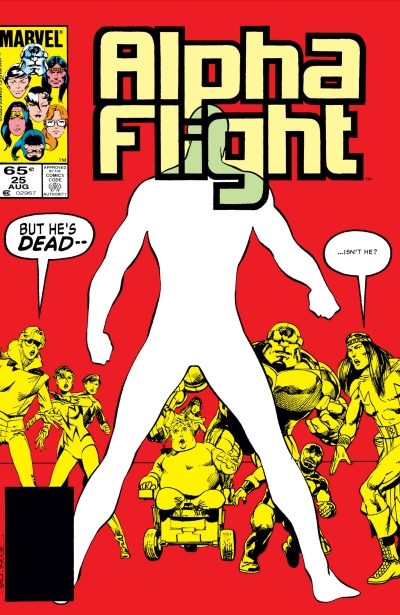 returned from the dead through a process that appeared to be too bizarre to be true. As it turned out, however, it was indeed untrue, as Guardian’s return was actually the plot of Omega Flight, Alpha Flight’s criminal counterpart, who had been involved in Guardians’ death in the first place. Fortunately, with the help of former Beta Flight members Box and Madison Jeffries, along with (inexplicably) the Beyonder, Omega Flight was defeated.
returned from the dead through a process that appeared to be too bizarre to be true. As it turned out, however, it was indeed untrue, as Guardian’s return was actually the plot of Omega Flight, Alpha Flight’s criminal counterpart, who had been involved in Guardians’ death in the first place. Fortunately, with the help of former Beta Flight members Box and Madison Jeffries, along with (inexplicably) the Beyonder, Omega Flight was defeated.
In the latter half of his last issue, Byrne had several of the Alphans attempt to locate and retrieve via an inter-dimensional lure a mindless body that might serve as Walter Langowski’s new host form. To their surprise, the form turned out to be the currently mindless Hulk, who had been exiled by Doctor Strange to the inter-dimensional realm known as the Crossroads over a year before in his own book. The Hulk’s violent return in the last panel of his last issue would serve as John Byrne passing the baton to Bill Mantlo, who would be taking over the book with Alpha Flight #29. In fact, Byrne was to take over the Incredible Hulk from Bill Mantlo with #313, so the writers were essentially swapping titles.
As noted before, John Byrne never cared for his creation and has been more than vocal about it in subsequent interviews and forum posts. Nonetheless, his work on the title during his two and a half years is highly regarded by Alpha Flight fans as it inarguably laid the groundwork on everything that followed. Over the years (and series) that followed, the concepts of Department H and Alpha Flight “junior teams” such as Beta Flight and Gamma Flight were revisited again and again. Along with the Great Beasts, Alpha Flight’s counterpart of Omega Flight returned multiple times, as well as arguably their greatest single foe, the Master of the World, and their alien foes, the Plodex. Although Alpha Flight #1 was reportedly a big seller (especially for the burgeoning “direct market”), the series was never among Marvel’s top books. Nevertheless, it has (and continues to maintain) a devoted fanbase who enjoy the heroes of the Great White North.
When he took over the title, Bill Mantlo already had a long career in comics. Aside from creating Cloak & Dagger, he wrote the Incredible Hulk for five years, almost every issue of Micronauts, all issues of ROM, as well as numerous issues of Peter Parker, the Spectacular Spider-Man and Iron Man. Although Mantlo apparently didn’t request any notes or insights from Byrne once he took over, he knew the series very well. However, that didn’t mean he agreed with everything and indeed acted quickly to reshape the team.
By the end of his first issue, Mantlo had not only resolved Byrne’s cliffhanger, but ended it with the Canadian government announcing that the new prime minister had restored Department H’s funding and that Alpha Flight would be given a free hand. This change in status brought Alpha Flight into being more of an Avengers North than its previous Defenders-esque status. While it 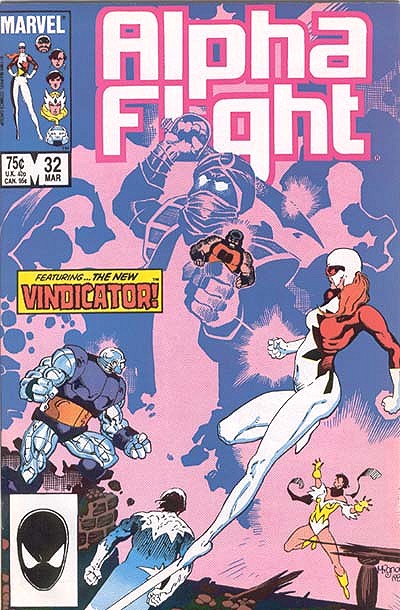 seems clear that Mantlo liked the idea of Heather Hudson remaining the team’s leader, he fundamentally disagreed with keeping her unpowered and got her into a Guardian costume as quickly as he could. By #32, Heather Hudson had become the new Vindicator.
seems clear that Mantlo liked the idea of Heather Hudson remaining the team’s leader, he fundamentally disagreed with keeping her unpowered and got her into a Guardian costume as quickly as he could. By #32, Heather Hudson had become the new Vindicator.
From the series’ beginning, Alpha Flight had more of a horror theme to it than most super-hero books. Aside from the Cthulhu-like Great Beasts, the team had faced foes that were at the least macabre. Whether consciously or not, Mantlo would continue this. Early on, he introduced Scramble, a mutant with the ability to manipulate flesh, much like the X-Men’s foe Masque but en masse and from afar. The results were horribly misshapen humans in nightmare form. He brought back Deadly Ernest, a Byrne-created character who could kill with a touch. He also introduced Pestilence (unrelated to the Horsemen of Apocalypse), a zombie-like demigod with power over decay and disease. Later in his run, Mantlo would also create Bedlam, a classic monster from an “experiment-gone-wrong,” and later still the extra-dimensional succubus known as the Dreamqueen, literally the stuff of nightmares.
One character that had a drastic change was Puck. In a solo story in #5, Byrne had made it clear that the heroes’ stature was due to achondroplasia (inaccurately mistyped as achondroplasty), a genetic condition which causes limbs to grow shorter in length and out of proportion of an individual’s torso. Among the many side-effects of this condition are various pains, which Puck referenced in his thoughts in the beforementioned story. Mantlo picked up on the notation of the pain and incorporated it into his plans for the character, though with a more supernatural twist. Whether he understood the reference to achondroplasia or not, Mantlo rewrote the character’s backstory, to make him a sort of Indiana Jones-type adventurer who had been born without any genetic disorder and had an above average height. On one of his adventures, however, Puck had inadvertently freed a malevolent sorcerer named Raazer, who had been trapped in an enchanted sword. To prevent his escape, Puck had used some magic skills he had learned to trap the sorcerer in Puck’s own body, the effect of which was to make him a dwarf. Likewise, up until Mantlo’s run, Puck had always seemed at peace with his stature and in fact presented as quite a ladies’ man. Now, Puck seemed ashamed of his size. Additionally, Puck suddenly expressed secret feelings for Heather and questioned how she might ever be able to love someone like him.
Just as Byrne seemed to have felt freedom in shaping the characters he created, Mantlo too seemed unconstrained with the characters he inherited and made drastic changes that resulted in an air of unpredictability in the series. For instance, not only did Mantlo kill off Snowbird, one of the original Alphans, but he used it as an opportunity to bring back Sasquatch, and in an unexpected way. Having been disembodied since the incident with the Hulk, Walter Langkowski’s soul found a new body in that of Snowbird’s reanimated corpse. However, when he reverted from 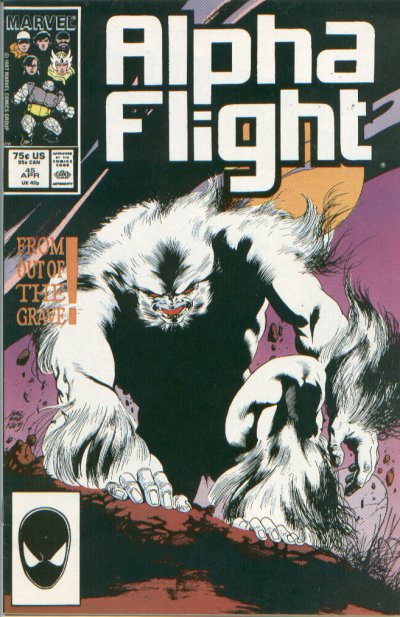 Snowbird’s Sasquatch form back to human, he discovered that he still had Snowbird’s female body. Walter coming to terms with now being “Wanda” Langkowski would be explored through the rest of Mantlo’s run.
Snowbird’s Sasquatch form back to human, he discovered that he still had Snowbird’s female body. Walter coming to terms with now being “Wanda” Langkowski would be explored through the rest of Mantlo’s run.
Along the way, Mantlo did create new characters for the team. One such character was the Purple Girl, daughter to the Daredevil villain, the Purple Man. Another was Manikin, a youthful doctor who had powers to create variations of himself based on different evolutionary stages of humanity. Later still, the characters of Goblyn and Laura Dean were introduced, twin sisters who inhabited different dimensions and could swap places, always connected but never together. These new, youthful characters would form a new Beta Flight.
As these characters entered, Mantlo had other characters exit. Shaman took on the mantle of Talisman (the title previously used by his daughter) and departed. While he did not create the character of the Forge-like technomorph Madison Jeffries, Mantlo did make him a member of Alpha Flight, first without a codename but then having him take over the Box identity from Roger Bochs, when the latter was killed in action.
Shortly after Bochs’ death in #49, two more Alphans departed from the book: Northstar and Aurora. Mantlo’s use of Northstar had been spotty at best. Mantlo had steered more heavily into Northstar’s abrasive and arrogant personality than had been done before. Like Byrne, Mantlo dropped hints as to the speedster’s apparent homosexuality and even embarked on a story that seemed to indicate that he was suffering from AIDS, a topical subject for the mid-1980s. However, 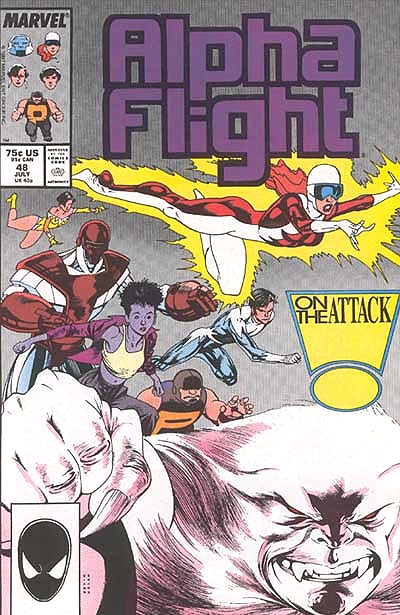 Mantlo eventually thought better of having Marvel’s ostensibly only gay character dying of AIDS and abandoned the plotline. More inexplicable, however, an encounter with Loki in #50 dropped the apparent bombshell that both he and Aurora were Asgardian half-elves, a seeming explanation for Northstar’s pointed ears. By the end of the landmark issue, the two were written out of the title, as was Puck, now returned to his “normal” height after his curse with Raazer was lifted.
Mantlo eventually thought better of having Marvel’s ostensibly only gay character dying of AIDS and abandoned the plotline. More inexplicable, however, an encounter with Loki in #50 dropped the apparent bombshell that both he and Aurora were Asgardian half-elves, a seeming explanation for Northstar’s pointed ears. By the end of the landmark issue, the two were written out of the title, as was Puck, now returned to his “normal” height after his curse with Raazer was lifted.
When John Byrne introduced the concept of Alpha Flight’s training teams Beta Flight and Gamma Flight in #1, he did so via two simple flashback panels. He later admitted that he had no idea who they might be and only fleshed them out as the story necessitated it. Perhaps so too did Mantlo when he introduced Laura Dean and her twin sister Goblyn first from a few panels in Alpha Flight #48. In fact, both the human-looking Laura and her demonic-appearing sister Goblyn looked nothing like they would when they next appeared in #53 (Laura was depicted as Caucasian instead of Black and Goblyn was purple instead of blue). However, through #53-54, the look of the two characters was cemented and Mantlo introduce the concept of them existing in different realities – one being Earth (which they called “Deadworld”) and the other being “Liveworld.”
Over the next few issues, from #55-60, the concept of Liveworld was elaborated upon and then visited by the Purple Girl, who found it a surreal, dreamlike land with islands floating in the sky. However, this realm was not lifeless. Rather, it was ruled by a sorceress who called herself the Dreamqueen, nearly omnipotent in her realm and who desired new worlds to conquer. Alpha Flight would eventually be drawn into the Dreamqueen’s Liveworld dimension but fortunately, despite her power, they were able to escape to Deadworld (Earth), where the Dreamqueen’s powers were far more limited.
Although one of the first things Mantlo did when he took the title was to reestablish Alpha Flight as a government-sponsored team, he nonetheless made sure that conflict remained between the two. The first sign of this was in #39, when the team learned that their government liaison Gary Cody had the ability to listen in on meetings at Maison Alpha. That same headquarters was destroyed when Cody attempted to activate the monstrous Bedlam in the misguided belief that it could be used against Alpha Flight if they ever turned against the government, as seen in #51-53. This plot thread came to the fore shortly in #61, just after Alpha Flight returned from Liveworld. 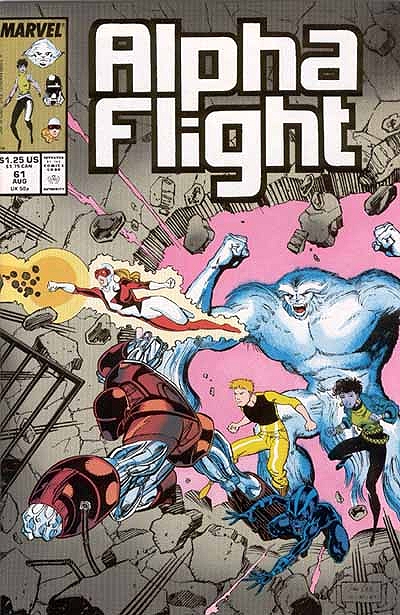 They were summoned to Parliament Hill for a parliamentary inquiry, the purpose of which was to bring the team under the direct control of Ottawa. To the surprise of the members of parliament, Vindicator rejected government funding altogether and returned the team to independent status, just where they had been before Mantlo took over.
They were summoned to Parliament Hill for a parliamentary inquiry, the purpose of which was to bring the team under the direct control of Ottawa. To the surprise of the members of parliament, Vindicator rejected government funding altogether and returned the team to independent status, just where they had been before Mantlo took over.
In #61 & 64, Mantlo also finally addressed the legal ramifications of Walter Langowski becoming Wanda Langowski. With Walter having been gone for some time, his ex-wife petitioned for him to be declared deceased, with all of his personal property being bequeathed to her. With no way to prove the fantastical story of his gender change, Wanda Langkowski lost everything.
Mantlo’s run on Alpha Flight ended with #66. Aside from #63, a one-shot story written by James Hudnall, who would take on the book after him, Bill Mantlo had written thirty-seven issues of the series, nine more than John Byrne. Not being a writer-artist as had been Byrne, Mantlo collaborated with others for the artwork, including some surprising names. While it had not been his first work at Marvel, Mike Mignola contributed on issues #29-31, along with a few covers and some inking later. For Jim Lee, however, Alpha Flight was indeed his first work at Marvel and his first issue, #51, would be a much sought after book for this reason. Lee also drew #53, 55-62 & 64 before moving to more high-profile titles.
